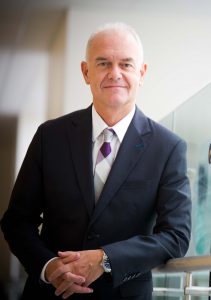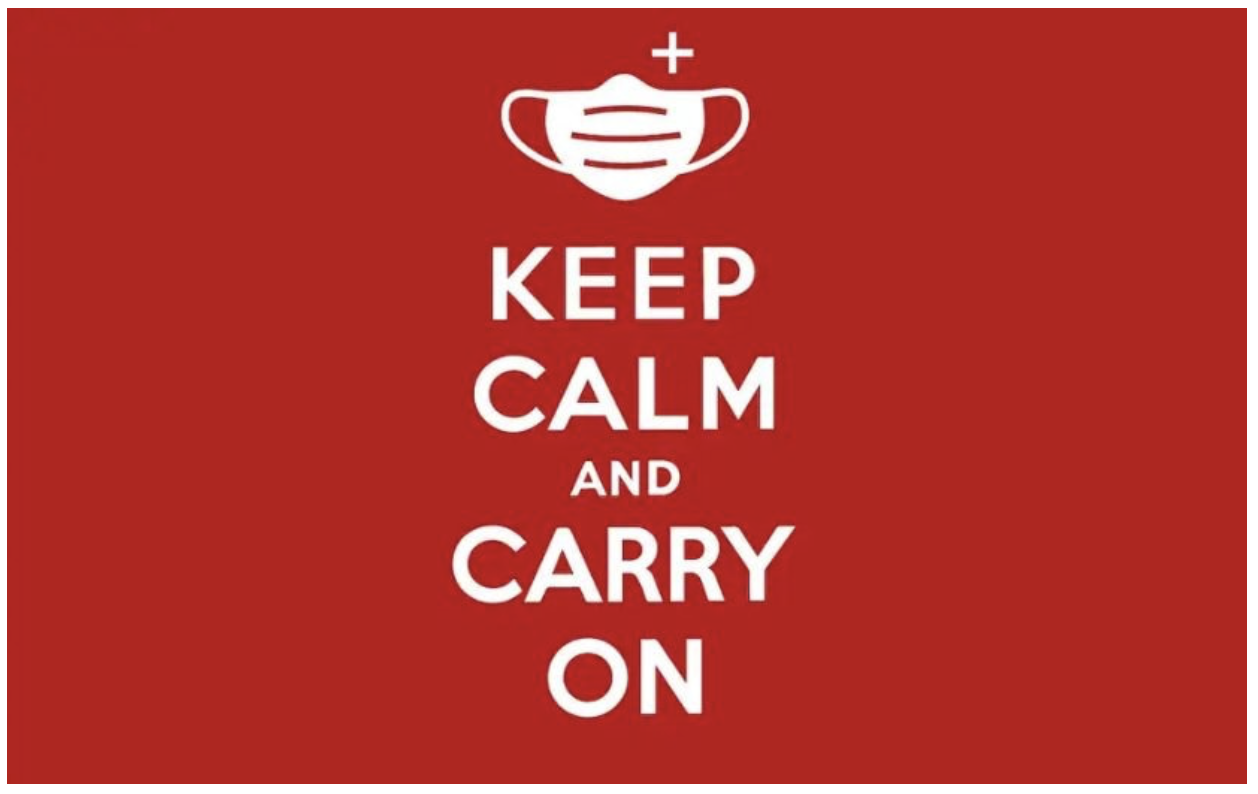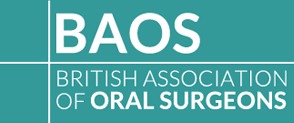Newsletter
President’s March 2020 Newsletter
The Oral Surgery Response to Coronavirus Disease (COVID-19).
Keep Calm and Carry On?
The iconic ‘Keep Calm and Carry On’ poster, first designed by the British Government in 1939, was based on the words of Sir Arthur Newsholme, Principal Medical Officer responsible for the whole of Britain. Sir Newsholme recommended that no action be taken against the 1918 flu pandemic as munitions factories and public services needed to remain open to help with the war effort. He made a huge mistake. Contrast with Dr James Nivin, Medical Officer of Health for Manchester, who recommended that schools and cinemas be closed to reduce people’s proximity to each other and published leaflets that were displayed around the city, advising residents on how to reduce the risk of becoming infected. Niven meticulously analysed statistics to be as informed as he could be so that he could give the people of Manchester the best advice on how to prevent exposure to the Flu. He saved countless lives.
Whilst it may be important to remain calm in adversity, and Oral Surgery training prepares us for this in the operating theatre, we need the best proactive evidence-based advice and risk assessment for managing our patients and ourselves in response to the coronavirus (COVID-19) pandemic. Countries are responding to the global pandemic in very different ways, from strict control over movement of individuals, to more liberal approaches, and reacting at very different speeds. All strategies are based on the best scientific evidence, but interpretation differs according to regional philosophical, social, political and economic ideology. Some have gone for containment with some success whilst others like the UK and others in Europe, the current epicentre of the pandemic, that are accepting delaying the inevitable spread of disease in their populations. China has used unprecedented containment and social distancing measures that would not be acceptable, and could not be readily be replicated in other countries, especially democratic ones with institutional protections for individual rights.
Singapore, Taiwan and Hong Kong have brought outbreaks under control without forced quarantines and containment and are now seeing the number of new cases reduce. Singapore authorities undertook intensive efforts to trace the contacts of patients known to be infected. Hospital staff went to great lengths to interview patients about their recent whereabouts; when information was unclear or unavailable, the Ministry of Health retrieved additional data from transport companies and hotels, including consulting CCTV footage.
Hong Kong has taken a different approach more focused on preventing transmission within the community. Local clinicians were asked to report to the city’s health authorities any patient with a fever or acute respiratory symptoms. The Universities of Hong Kong and Singapore closed in January for four months, including their Dental Schools and Hospitals other than for emergency care. South Korea, probably one of the most technologically advanced countries in the world, has gone like others for early identification through widespread testing. This is based on a belief that asymptomatic individuals are infectious.
The UK NHS advice has been to continue with general dental care using routine personal protective equipment (PPE) unless a patient has symptoms. Patients who have symptoms should not be attending for dental treatment and should self-isolate. Patients who are symptomatic and/or who have COVID-19 and need urgent dental care that cannot be delayed should be treated with clinical staff using appropriate PPE by a service equipped to deal with them. In this scenario aprons, gloves and a fluid repellent mask should be used whilst assessing and treating patients. Gowns, gloves, FFP3 masks and eye protection should be used whilst performing aerosol-generating procedures.
China has had a different approach for general dental care as described in a recent paper by clinical academics at Wuhan University School and Hospital of Stomatology (1). I understand from direct communication with one of the authors, Fang Hua, that all provinces, one by one, initiated their, ‘Level 1 Response to Public Health Emergencies’ around 20th January when it was determined that COVID-19 was spread by interpersonal transmission via respiratory droplets and contact. This included the suspension of all routine dental care and provision of care for emergencies only. As new cases have reduced dramatically in most provinces, the provision of routine dental care is gradually getting back to normal. Finding ways to reduce aerosol for emergency patients is described in the paper. Patients with serious oral and maxillofacial injuries were admitted and a chest CT was used to exclude suspected infection rather than await the time-consuming RT-PCR test.
The Chinese view has been that due to the unique characteristics of dental procedures, where a large number of droplets and aerosols could be generated, the standard protective measures in daily clinical work are not effective enough to prevent the spread of COVID-19, especially when patients are in the incubation period, are unaware they are infected, or choose to conceal their infection.
Splatters created during oral surgery procedures, are like aerosols, also contaminated by respiratory pathogens. The UK view is that asymptomatic patients should be treated as usual with standard PPE. What therefore is the evidence for transmission from asymptomatic patients? There are now reported cases of transmission of infection during the incubation period (2) but there is little information about the quantification of the viral shedding during the incubation period or subclinical infection compared to symptomatic infection. It is therefore difficult to assess the risk of treating asymptomatic patients.
The National Health Committee of China has stated in relation to COVID-19 that ‘Exposure to high-concentration contaminated aerosols in a relatively closed space for a long time, may lead to transmission of COVID-19 via aerosols’. The Chinese recommendation to minimise aerosol-generating procedures during dental procedures seems sensible and a paper produced during the SARS outbreak provides detailed suggestions on this (3).
It is important that Oral Surgeons act professionally and with compassionate non-judgemental attitudes to patients in this viral pandemic as we have learned from previous experiences such as the HIV/AIDS outbreak (4). We need to be confident in the clinical care that we provide and knowledgeable of the precautions to prevent cross infection. The general public would expect this of us. We are familiar with risk assessment and surgical practice to reduce the prevalence of occupational related-health problems such as percutaneous injury and hepatitis B and hepatitis C. Interestingly a systematic review has shown that we are actually more concerned about musculoskeletal disorders! (4)
In my personal opinion it would be sensible to use gowns, gloves, FFP3 masks and eye protection for all oral surgical patients whether symptomatic or not to achieve maximum protection. In hospital and most primary care settings this standard is not difficult to achieve. I would be anxious to provide any type of dental clinical care without the appropriate PPE and this is a real issue given the huge increase in demand. I have made the decision to close my own Barts and The London Dental School at QMUL to patient care undertaken by students at the end of today. Non-clinical teaching will continue until the end of this week and then move completely to on-line teaching with review in six weeks time. Students are at higher risk of occupational incidents and our stocks of PPE are low. Staff who themselves are at risk because of medical compromise are being advised to work non-clinically from home until the pandemic ends.
Planning for our own local service is important. I set up a, ‘Covid-19 Planning Team’ some time ago with responsibility for collating information to inform our decision-making. Views and advice have been sources from the University, Dental School Council, Medical School Council, General Dental Council, affiliated Hospital Trust, WHO, UK National Health Service (NHS), Public Health England (PHE), NHS England, Health Education England and more. We need to be confident about our PPE, communication and expectations so that we can look after ourselves so that we can look after our patients. If you are in hospital practice then you will be already receiving information on how to prepare in your own setting.
The next few weeks will bring huge changes to UK healthcare provision as our NHS struggles to cope. The UK delay approach is an attempt to manage Covid-19 disease to better match capacity of services. It seems that ‘flattening the curve’ is not intended to change the ‘area under the curve’ and so the pandemic can be expected to with us for many months. Recently retired staff are likely to be brought back into the workforce and clinical academics, including ACFs and ACLs, are likely to be providing full-time clinical service. Elective hospital surgery will be cancelled so that theatres can be transformed into ITU wards, private sector hospitals will be used by the NHS, and it is expected that hotels will transformed to provide additional clinical capacity.
It is clear at this time that there is huge need for research evidence in our world of oral surgery to develop consensus on infection risk and research evidence-based infection control guidance specifically for dentistry and our speciality. There has been a proposal for a Clinical Oral Microbiology Hub and Spoke Service to support healthcare professionals. I support such a proposal! The UK dental specialty of Oral Microbiology needs development to ensure contingency and succession planning. The speciality would also have a role in diagnosis, surveillance and the management of orofacial infections. Some dental professionals and Oral Surgeons may have social and psychological anxieties that prevent them from providing clinical care and this can be alleviated by good underpinning science.
We are still in the ‘calm’ before the storm so take a leadership role and get planning if you haven’t done so yet! It’s going to be a while before Oral Surgery, our health services, and possibly society, returns to normal, probably a new normal. We need to engage in a spirit of collaboration, looking out for each other, our patients, especially our vulnerable patients, our staff and our referrers. We also need to take seriously our own mental health and wellbeing and plan to support others in our oral surgery community. Keep calm, but plan ahead, and use appropriate personal protective equipment.
This paper expresses the personal opinions of the author.
Kind regards,
Professor Paul Coulthard, BAOS President

16 March 2020

References
- Meng L, Hua F, and Bian Z. Coronavirus Disease 2019 (COVID-19): Emerging and Future Challenges for Dental and Oral Medicine. Journal of Dental Research: 2020; DOI: 10.1177/0022034520914246.
- Rothe C, Schunk M,Sothmann P, Bretzel G, Froeschl G, Wallrauch C, Zimmer T, Thiel V, Janke C, Guggemos W, Seilmaier M, Drosten C, Vollmar P, Zwirglmaier K, Zange S, Wölfel R, Hoelscher M. Transmission of 2019-nCoV Infection from an Asymptomatic Contact in Germany. N Engl J Med 2020; 382:970-971 DOI: 10.1056/NEJMc2001468
- Li RW, Leung KWC, Sun FCS, Samaranayake LP. Severe Acute Respiratory Syndrome (SARS) and the GDP. Part II: Implications for GDPs. Br Dent J, 2004:197,130-134.
- Coulthard P, Tappuni AR, and Ranauta A. Oral Health and HIV: What Dental Students Need to Know. Oral Diseases. In Press.
- Moodley, R., Naidoo, S., & Wyk, J. V. (2018). The prevalence of occupational health related problems in dentistry: A review of the literature. J Occup Health, 60(2), 111-125. doi:10.1539/joh.17-0188-R

